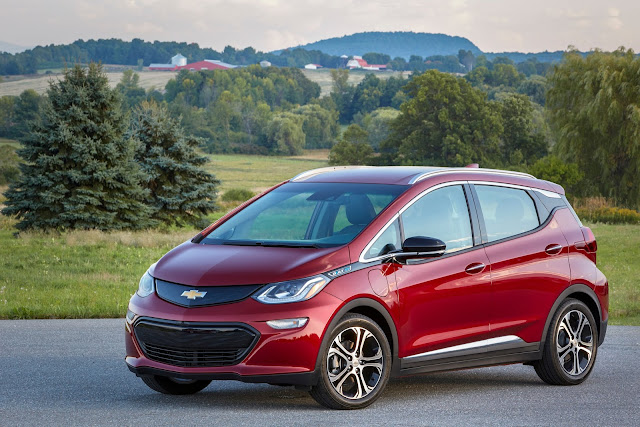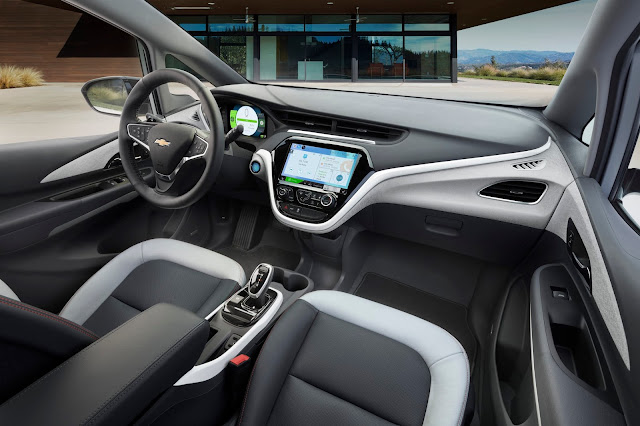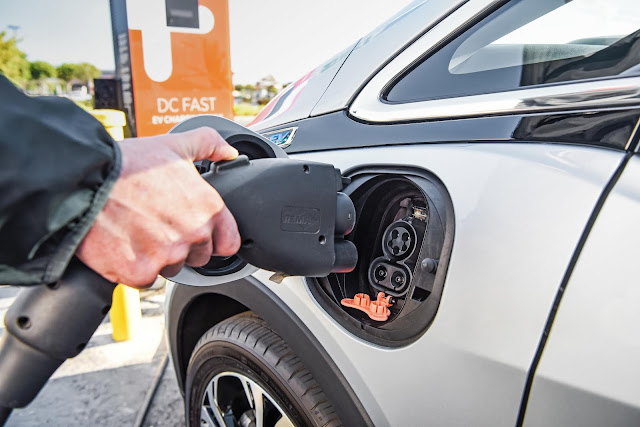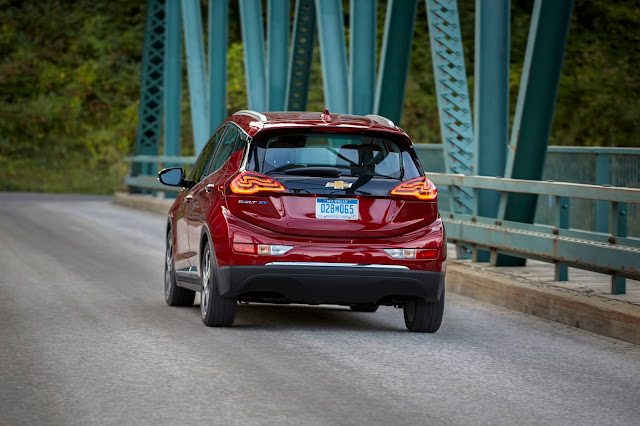 |
| The 2019 Chevrolet Bolt EV. |
It's great to be able to meet you again, I hope you are happy with the informations that I will share with you. As for the information that I will share about the automotive.
It has become clear, at least to me, that the time is coming, and soon, when there will be an electric vehicle (EV) with so few compromises in terms of range and charging time that it will tip the scales and the internal combustion engine (ICE) will become merely a segment of the automotive marketplace, one that, from that point on, will be doomed to shrinking market share and an eventual extinction.
In the past two years, two automobiles have arrived that some have said are those cars---the Tesla Model 3 and the Chevrolet Bolt. Another much-anticipated electric, the Hyundai Kona EV, is on its way. We've yet to drive the Tesla (but until one can actually be bought for anywhere close to the promised $35,000 price---most are rolling out the door well over $50,000---it's not going to be the car that alone turns the tide) or the Hyundai, so that leaves us, for now, to examine the Bolt.
 |
| 2019 Chevolet Bolt EV interior. |
Taken on its own, there's a lot to like about the Bolt. Like the Tardis, it's bigger on the inside, a basic marvel of packaging made possible by its high roof and flat floor. It helps to think of what's under the body as basically a roller-skate in profile---front wheels and electric motor, flat floor back to the batteries and rear wheels.
It's also quick, though if you drive it quickly, you'll deplete the battery more rapidly---taking away one of the Bolt's strongest selling points, it's EPA-estimated 238 mile range on a full charge. And here's what a breakthrough that 238-mile range is. Prior to this test, the best range we'd seen from a pure EV is 93 miles from the 2015 Kia Soul EV. The Bolt doubles that and adds 52.
As good as that sounds, and is, for certain people, let's consider whether a typical driver---yours truly, for example, could live with one as his or her only automobile.
First, I live by a hard-and fast rule, taught to me by several of the best helicopter pilots in the business during the 30 years I made my living in TV news: The last 20% of a tank of fuel never leaves the tank. I have bent that rule exactly once---on our summer 2017 two-week roadtrip in the Mazda CX-9 Grand Touring. Well, actually, I intended to bend that rule rather than add a 90-mile roundtrip to pay for my own mistake, but was saved by a gas station that didn't show up on the GasBuddy app, so I really didn't even drop below 50%.
But that means that, EV charging stations being considerably less plentiful and predictable than gas stations, the rule should apply here, too---meaning I would only use 80% of the car's range before recharging. For the Bolt, all things being equal, that's 190.4 miles between charges.
 |
| 2019 Chevrolet Bolt at a Level 2 charger. |
But, with EVs, even more than with ICEs, all things aren't equal, at least not all the time. Your driving style and traffic conditions can impact your range with both electric and gasoline, but batteries react to temperature---becoming less efficient in cold weather. Here at TireKicker World Headquarters in suburban Sacramento, California, we've had a few nights in the 30s---and that's enough, causing the range indicator to show 215 miles on a full charge instead of 238. That knocks the range between charges---allowing for that 20% rule ---down to 172 miles.
Yes, there are things like regenerative braking that can put miles back on the range meter, but those aren't miles you can count on, depending on conditions.
And when you need that charge---it can take a while. Tesla's Supercharger may get all the press for its ability to do a full charge of its cars in a little over an hour, but the Supercharger only works on a Tesla. The Level 2 chargers you'll find at shopping malls and office buildings---the kind you absolutely should have installed in your own garage if you buy an EV---they take 9.3 hours to bring a Bolt up to a full charge.
 |
| 2019 Chevrolet Bolt EV at a DC fast charging station. |
Less common than the Level 2 chargers are the DC fast charging stations. The best $750 a Bolt owner can spend is to say yes to the optional DC fast charging provisions. That will allow you to use a DC fast charger. Chevrolet says you can get up to 90 miles of range in 30 minutes on an 80kw DC fast charger. Which is nice, except that the only DC fast chargers currently in use in America are 60kw.
So figure a bit less range or a bit more time. Still, doing the math, never going below 20% charge, you ought to be able to get a full recharge from a DC fast charger in about the same hour and a few minutes that Tesla can deliver from its Superchargers. There are just fewer DC chargers as of this writing, and there's usually only one, along with two or three Level 2s, in a typical shopping center parking lot.
Yes, there is a cord that allows you to charge at home on your household current. Chevrolet says you'll get four (yes, four) miles of range per hour. Taking a Bolt from 20% to a full charge on household current would take 43 hours.
My friend and fellow Western Automotive Journalists member Steve Schaefer found EV religion a couple of years ago, bought a Bolt and changed his website to SteveGoesGreen. We chatted a bit via Facebook Messenger about his experience and mine.
Steve actually makes do with the household current charger. But he has a Level 2 available at his day job (I don't, unless I want to walk half a mile from either a nearby mall or a nearby medical plaza---and I don't feel right about leaving my car on someone else's charger for a few hours, possibly depriving another EV driver who needs the charge more than I do). Even so, this spring, he plans to put a Level 2 in his garage as part of another home project.
Here's the kind of situation that keeps me from saying the day is here: I did a full charge on Sunday, December 23. The range meter said 215. The next day (Christmas Eve), I drove 50 miles to and from work. That should have knocked the range down to 165, but it read 160 when I pulled into the driveway---leaving me with a Christmas dilemma. The next afternoon, Mrs. TireKicker and I were having Christmas dinner with her daughters at the eldest's house---a 90 mile roundtrip.
That would be fine, leaving me (theoretically) 75 miles with which to drive the 25 miles to work on Wednesday---leaving 50 miles for the guy from Page One Automotive when he picked up the car between 11 and noon. Oh, yeah---and I was working the early morning shift---leaving the house at 3:30 a.m. If everything went right, I'd just be making the 20%.
But I wimped out and spent about an hour of Christmas morning at the DC fast charger in front of the neighborhood supermarket. And it's a good thing---because I took a less-efficient route to stepdaughter's than I should have, we stayed later, it was cold----and the swap to the next vehicle was delayed--meaning I had to get 25 more miles out of the charge than I had planned. Being brave probably would have gotten me stranded.
 |
| 2019 Chevrolet Bolt EV. |
Sure, if it were my Bolt, I'd have a Level 2 charger in my garage (making up for the lack of one at work) and it would be worth the additional money invested (I've seen quotes as low as $600 and as high as $2,000). But I still felt more range anxiety than I expected in my week with this groundbreaking car.
For me---I think the tipping point will be 500 miles of range and DC fast charging that can replenish that in an hour. At that point, I can see making the change to EV. But as they say in the gasoline-powered car ads, your mileage may vary. And for a lot of people, the Bolt is already a great solution.
2019 Chevrolet Bolt Premier
Base Price: $40,905
Standard Equipment:
- Tire pressure monitoring
- Theft-deterrent system
- Stabilitrak
- Four-wheel disc antilock brakes
- Rear camera mirror
- Surround vision rear view camera
- Lane change alert
- Side blind zone alert
- Rear park assist
- Rear cross traffic alert
- Pedestrian safety signal
- Automatic headlamps
- 17-inch ultra-bright machined painted aluminum wheels
- All-season puncture-sealing tires
- Outside heated power-adjustable mirrors with turn signal indicators
- HID projector headlamps
- LED daytime running lamps
- Keyless open and start
- Remote vehicle start
- Leather-appointed seats
- Six-way front heated bucket seats
- Heated rear seats
- Leather-wrapped steering wheel
- Tilt and telescoping steering column
- Automatic air conditioning
- 10.2 inch color touchscreen
- Apple CarPlay and Android Auto
- 4G LTE wi-fi hotspot
- SiriusXM All Access
- Six-speaker audio system with USB ports
Extra-cost options:
- DC fast charging provisions ($750)
- Driver Confidence II Package (automatic high-beams, following distance indicator, forward collision alert, lane keep assist with lane departure warning, low-speed forward automatic braking, front pededstrian braking with pedestrian detection) ($495)
- Infotainment Package (wireless device charging, Bose premium seven-speaker audio system, dual USB charge-only ports in rear) ($485)
Destination charge $875
Total Vehicle Price: $43,510
EPA fuel economy estimate 119 combined city/highway MPGe
EPA estimated range: 238 miles
Lastly I said thank you very much for visiting my blog. I hope you are happy with the information that I have provided, If you think this is useful, please share it with anyone you want.
The 2019 Chevrolet Bolt EV
 Reviewed by dicky
on
06:00
Rating:
Reviewed by dicky
on
06:00
Rating:
 Reviewed by dicky
on
06:00
Rating:
Reviewed by dicky
on
06:00
Rating:







No comments: